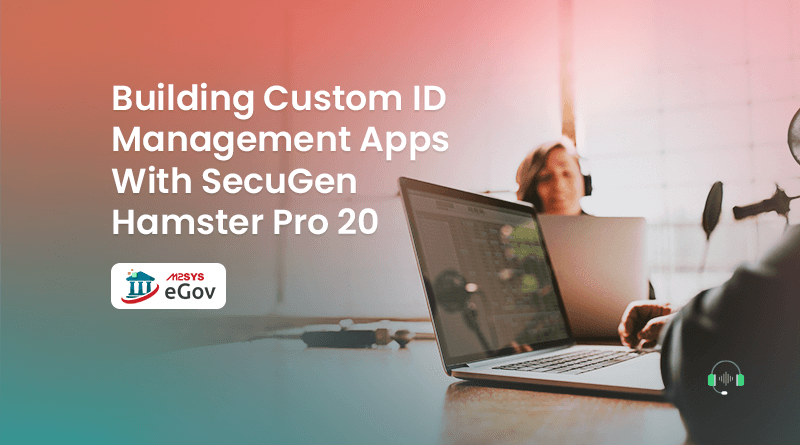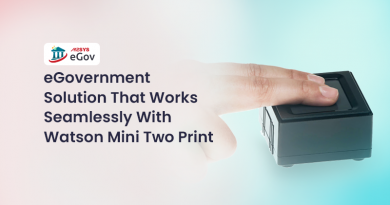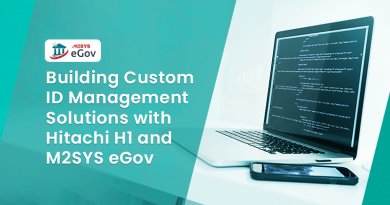M2SYS Podcast – Building Custom ID Management Solutions With SecuGen Hamster Pro 20
One of our experienced engineers in the Identity Management Team, Taushik, talks with Salman about SecuGen Hamster Pro 20, a popular biometric fingerprint device and its use cases. They also talk about how easy it is to create custom identity management solutions for government biometric projects with the M2SYS eGov platform and SecuGen Hamster Pro 20. They also discuss how the eGovernance solutions created with M2SYS eGov work with any biometric hardware, matching engine, and third-party system without writing a single line of code – helping rapidly develop and deploy custom solutions for large-scale identity management projects.
Podcast Transcript
Salman: Today, we’re going to talk about a popular biometric device that has been used across several industries. For that, we have one of our experienced engineers with us today, Mr. Taushik. So Taushik, thanks for joining us—why don’t you tell us a little bit about yourself?
Taushik: Hi, I’m Taushik, and I’m working as a business automation engineer for quite some time now. I’m currently working on different identity management solutions across the world.
Salman: That’s great. So, Taushik, why don’t you tell us what kind of device we’re looking at today?
Taushik: So today we will be focusing on Secugen Hamster Pro 20. I have this device with me right now, so this is the device. As you can see, this is a USB fingerprint reader. It’s very small, compact, lightweight, and handy. And it uses the industry’s most rugged and advanced optical sensor using patented fingerprint technology.
Salman: Yeah. So, what is the most common use of the SecuGen Hamster Pro 20?
Taushik: I would say workforce management, for example, time clock applications, right? So, employees come into their workplace punch-in by scanning their fingers, and follow the same process while punching out. And these punch-in and punch-out times are basically rush hours where they perform consecutive scans one after another. In this scenario, if I talk about other biometric scanners, then we would need to wipe out the surface after every five to six scans, but it’s not the same for this device. You can keep on scanning for a long time and it will give you very good scans.
Salman: OK, sounds like a very heavy new device.
Taushik: Yep, it is.
Salman: Yeah. So other than, let’s say workforce management, can it be used for any other projects?
Taushik: Yes, you can use this with any other identity management solutions. In fact, if I talked about our platform, you can use this device with any application you would like.
Salman: OK, so will you be able to show us a quick demo?
Taushik: Yeah, sure, let me share my screen. So, basically, this is a demo platform where we have built a variety of applications that you can see from management to law enforcement systems, birth registration, and border management system. So, this is a very powerful platform where you can build starting from easy applications to complex applications.
No matter what kind of application you would want to develop, you can do it here without knowing a single line of code. I don’t have to know any line of code and I have made all these applications by myself. So, how? We use drag-and-drop editors, use custom workflows, automation, and reports. You don’t have to know any development or coding knowledge.
How? Let me show you our Pension Management System. What you are seeing right now is a custom-made dashboard that was made on the go. So, how easy is it to build this dashboard for the entire application? If I go to the design side where we actually build the application or make changes as necessary, this is the form structure. If I, for example, go to the pensioner form where we provide demographic information and all the pertinent details necessary for pension management? So, what you’re seeing right now is the mobile UI.
Salman: Yeah. So, it’s available for both web and mobile?
Taushik: Exactly. No matter what changes you make, it will reflect in both web and mobile applications. So, you can also view that on the design side as well, like how the mobile UI would look Inside the form. So, let’s switch to the web. So, for example, this is a Calendar controller date field. So, if the requirement is changed to the middle of the project and they’re like “Hey, I want, I want the users to manually input the dates,” so you can just drag a text field here, name this the date of birth, I’m using small letters so that we can distinguish between the two dates of births, and click save.
So, you will be seeing this change—it will be reflected in both mobile and web versions.
If I show you the app designer, where we can design the theme—what theme will you choose? What are the icons, logos, or menus you would want to see?
Salman: So, basically, everything is customizable.
Taushik: Exactly. For example, I want to change the theme. So, currently, you are seeing a blue theme—I want to change it to red. So, the entire application’s theme will be turned red. If I want the menu on the top or on the left—it’s entirely up to you how you want to customize it and how you want to design the app. I’m enforcing this again—you don’t need to know any single line of computer coding—you don’t need that. You can add workflows and the best part of the eGov platform is you can use any kind of biometric hardware and biometric matching system you’d like. You don’t need to go to lengthy SDKs and try to connect the device to work with your software—it’s basically plug-and-play.
Salman: Can you show us a demo of the platform with the device?
Taushik: Sure, let me show you.
Right now, the biometric device is disconnected from my machine—let me connect it. If I launch the app and connect the biometric device with my machine as we speak. See the red light? It’s connected. I’ll be registering my right index finger with the record of Anna—let me start.
Salman: So, you’re trying to enroll yourself under Anna’s record using your fingerprints.
Taushik: That’s correct—let’s say I want to add my biometric data and tag them with a pensioner, Anna. I want to register my index finger with the record.
As you can see, the system gave me a warning that I already have the biometrics of my index finger registered with an existing record. Our eGov platform stops you from creating duplicate records. Now, let me check which record comes up when I scan my index finger. As you can see, my index finger is registered with the record Albert K. Nash. The platform stops me from creating duplicate records using biometrics.
If I try to use different fingers, let’s say my ring fingers, to register with Anna’s record, it will enroll my biometrics with the sample record. If I want to verify or identify a person, for example, from millions of records, I can simply search simply using biometrics. I’ll click on the biometric search icon, use my ring finger that I just used to register with Anna’s record, and as you can see, Anna’s record is pulled up.
Salman: Basically, you showed us that our eGov platform prevents duplicate records and also identifies using biometrics.
Taushik: Yeah, and also, you can enroll individuals using biometrics.
Salman: That’s great. So why don’t you give us a real-life example of where the platform was used and where you made customizations on the fly?
Taushik: Sure. We have this project in the Middle East, where, in the middle of the project, the customer wanted to use a different fingerprint scanner from the one that was initially planned. They reached out to us saying that their agreement with the previous biometric hardware provider was over and we’re in a contract with a different manufacturer. Sounded like they had a bad experience of developing a biometric capture tool from scratch—which is quite a complex process. As biometrics is a very human-oriented technology, it takes years of experience to make it right, and as we have that, it was easier for us to manage this requirement.
They just connected the new biometric devices with their machines and it was ready.
Salman: To summarize this session, our eGov platform can be used with any biometric hardware, matching engine, and third-party system. It can also be used to create custom ID management solutions without writing a single line of code.
Taushik: Yes, just like I showed you.
Salman: Since you worked on a lot of projects like these, what do you think makes the customers choose us over others? What sets us apart from others?
Taushik: They can rapidly develop and deploy solutions, experience shorter development cycles, and require fewer resources as it’s a no-code platform. if you think about a traditional biometric solution, you’d need to hire a bunch of resources and tie all the components together. With eGov, none of this is required and users can rapidly develop, customize, and develop solutions. It removes the cost, hassle, and headaches associated with development and maintenance associated with traditional solutions.
Salman: Thanks a lot, Taushik, for your time today and for being such a great guest—stay tuned for more on eGov and how easily it works with any popular biometric hardware.










